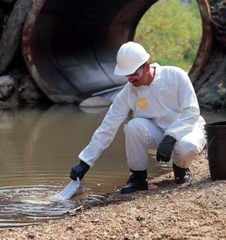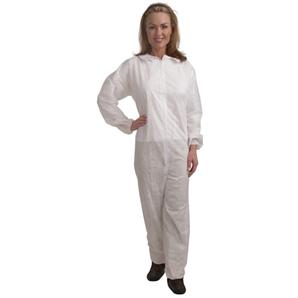LEARN MORE about disposable protective coveralls

Tyvek disposable coveralls on the job
©
From work place dust to work site dangers, coveralls provide different levels of personal protection from head to toe
The advent of disposable clothing was made possible by 20th century technologies and materials that produced durable, lightweight and filtering and/or impermeable non-woven fabrics that were comfortable enough to wear and inexpensive enough to discard. These specialized fabrics are widely used for disposable protective clothing or garments such as coveralls, overalls, jumpsuits, hair covers, shoe covers, boot covers, lab coats, and sleeves that shield against common work place hazards. A wide variety of non-woven materials and layered combinations offer several levels of protection.
DuPont Tyvek® protective coveralls are made with a unique DuPont non-wovens technology for lightweight, comfortable, inherent barrier protection against dry particulate hazards and light liquid splash. Even after abrasion, Tyvek disposable coveralls stop sub-micron particles better than reusable garments. White Tyvek suits repel most non-hazardous liquids and particulates. Applications include painting, general maintenance, dry chemical applications, construction, automotive, fiberglass, agriculture, food processing, environmental cleanup, abrasive blasting, woodworking, mining.
DuPont Tychem® QC clothing uses a polyethylene-coated Tyvek fabric to provide extra resistance and protection against light liquid and chemical splash. Bright yellow color provides contrast across a wide range of natural backgrounds for high visibility in the workplace. The lightweight fabric is durable and resists tears and abrasion. Ideal for use in processing and manufacturing facilities such as food and chemical processors, petroleum refineries, and pulp and paper mills.
ViroGuard protective clothing uses a comfortable blue fabric that offers enhanced moisture vapor transmission for increased breathability yet holds out many dangerous liquids and particulates. Passes ASTM F1670/1671 testing for blood, body fluids and blood-borne pathogens. Applications: Research facilities, emergency response and crime scene remediation.
PyroGuard FR fire-retardant disposable garments for workers with flammability requirements are made of a tough, breathable, lightweight, white cloth-like material with a base fabric of hydro-entangled wood pulp and a top layer of polyester that is topically treated with a phosphate-based flame-retardant chemical. The fabric chars at temperatures below its ignition point, so there is no flaming or molten drip and the fabric retains its rigid structure. Passes NFPA 701, 1989 and 1999 methods. Applications: Electrical contracting, petroleum refining, electric utilities, chemical manufacturing, welding, aluminum manufacturing, and steel foundry.
Microporous disposable coveralls are constructed of lightweight, breathable and durable fabric, comparable to Tyvek, that combines microporous film and nonwoven polyolefin to provide a protective barrier against particulates, aerosols and non-hazardous liquids. Applications: Agriculture, lead remediation, asbestos abatement, spray painting, food processing, sanitation engineering, inspection and pharmaceutical manufacturing.
 Polypro disposable clothing is constructed of lightweight, economical spunbonded polypropylene that provides protection against dust and direct or incidental aerosol mist. Ideal for keeping clothes clean in dusty, dirty, non-hazardous environments. Lightweight and standard-weight Polypro options provide a choice of protective levels and economy. Applications: Cleaning, sanding, dirty repair jobs, dusty environments like grain and mill operations, light painting.
Polypro disposable clothing is constructed of lightweight, economical spunbonded polypropylene that provides protection against dust and direct or incidental aerosol mist. Ideal for keeping clothes clean in dusty, dirty, non-hazardous environments. Lightweight and standard-weight Polypro options provide a choice of protective levels and economy. Applications: Cleaning, sanding, dirty repair jobs, dusty environments like grain and mill operations, light painting.
SMS disposable apparel is constructed of a breathable, durable fabric made of three layers of polypropylene material. One layer of meltblown poly is sandwiched between two layers of spunbonded poly. Provides outstanding abrasion resistance plus protection from non-hazardous liquids and particulates. Compares to DuPont® ProShield® NexGen® clothing. Applications: Asbestos abatement, food processing, painting, tank cleaning, mold remediation.
Disposable Clothing Seams
Serged seams are sewn using a serge stitching. A serged seam is produced when three threads are interlocked around the raw edges of two pieces of material for a strong, stress-resistant seam. Serged seams are not liquid or particle tight. Serged seams have minimal liquid and particle holdout. The use of serged seams should be limited to light particle loading and liquid mists. Serged seams are not suitable for pooled liquids.
Bound seams are tightly sewn and have a reinforced outer binding to enhance seam strength and barrier. Bound seams are suitable for light particle exposure and liquid misting. Bound seams are not liquid or particle tight. Bound seams are not suitable for pooled liquids.
Back